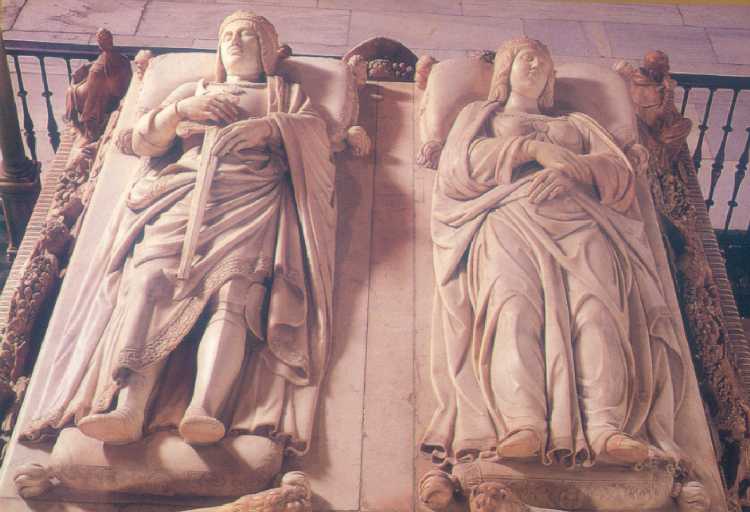Day two in Granada got off to a lazy start. We woke up around 10 AM, and we started looking around for breakfast. We settled on a cafe in front of a church.
 |
| Churros con Cafe |
Poor soul.
The Catholic Monarchs' crowning achievement (pun intended), according to them, was expelling the Moors from Spain and finishing the Reconquista (They never quite knew what an big deal discovering America would be). Because of this they decided to have their human remains rest in the last city they conquered back, Granada. A Royal Chapel was commissioned by them and built in what would become the center of the Christian city. A much, much larger Cathedral was then commissioned by their grandson Holy Roman Emperor Carlos V, which intended to hold the mortal remains of the Monarchs and of Carlos V's parents (the Monarch's daughter and son-in-law). In the end, the bodies stayed in the chapel, and the Cathedral was sort-of built around it.
We walked in and were told that we couldn't take any pictures, but I managed to pull some from the internet. It's first and foremost a church, so you get your usual large gold-gilded altar pieces. This church, following the Monarchs' orders, was dedicated to St. John the Baptist and St. John the Evangelist. The main altar piece included a pretty graphic image of St. John's head on a platter, with his anatomically-correct headless stump still kneeling.
In front of the altar rose two large marble sarcophagi. They had the figures of the Catholic kings laying side by side, as if lying in-state for all eternity (Kind of romantic if you think about it. Not so much when you realize that Ferdinand remarried a year after her death).
The other sarcophagus had the figures of their daughter and their son-in-law in a similar position.
A short flight of stairs led down to the underground crypt, sealed by a large wooden door with a glass window. Looking inside you could see the caskets of Ferdinand II of Aragon, Isabella I of Castille (along with some of their relatives).
It is both really morbid and strange to think that their bones are lying in front of you. People who changed the entire face of the Earth by commissioning the discovery of America and uniting Spain into what it is today.
The rest of the building was a museum, showing the clothes and relics of the monarchs. The pieces of clothing that they wore were so opulent they were woven with literal gold thread. In a glass case in the middle of the museum was the Queen's crown and the King's conquering sword.
We came out of the church feeling a bit down and meditative. We came across this:
Flamenco musicians speak of Duende, a certain creative state of mind that is hard to describe (and even harder to translate). I never quite got it until I watched an actual flamenco show in person. The dancer's feet move faster and faster, and it is them that dictate the tempo of the song. The cajon player, the guitarist and the singers all look at the dancer's feet to know where the song and the performance will go from a particular point. There is a lot of improvisation, and the duende in the music and the artists carries into the audience. You sort of become part of the song, and some of the locals actually started clapping, singing or randomly yelling ole or dale at the musicians and dancers. The stomping and clapping and mournful singing start pulling you in and affecting you at a very primal level, to the point that you're completely mesmerized.
After the show, it was right around siesta time and we were looking to go back to the apartment until a large crowd blocked us off.
Granada wasn't pulling any punches. It was intent on giving us the whole deal; flamenco, tapas, processions and all. I still don't know why there was a procession the day that we were there, but I wasn't complaining. I had heard of the Holy Week processions and how thousands of people come down to see the massive floats carried on people's shoulders and the menacing hooded figures. This was something different yet still evocative of those scenes. Much more informal, with school-aged children and young men and women. The crowds weren't as big or suffocating, mostly made up of (what I assume) were the family members of the kids involved. The Jesus float was being carried by a group of high school-aged girls, while the Mary one was being carried by guys around their same age. They all marched to the blaring sound of a solemn brass band, with musical progressions that are very reminiscent of Spanish bullfighting music. All this was happening in the heart of the city, coming out of an alley leading to the Cathedral and towards the statue of Columbus and Isabella that gives the Gran Via its name.
After the procession we did find our way back home, where we regrouped for later during the day.
After a walk up the Albayacin one more time to look at the Alhambra one last time before we actually explored her first hand, we went to a Flamenco show. We climbed down the Albayacin and up the Sacromonte's steep, picturesque hills.
 |
| You can see the old city wall in the back |
The music was different from the one we heard that afternoon. Not better or worse, just different. I believe that's the nature of this music, every time it's different. This time around, the crowd wasn't as invested. The musicians still played their hearts out and I was again lured into the steady strumming and the heel stomps that were amplified by the perfect acoustics of the domed room.
Granada had given us all it could today, but it reserved its biggest experience for tomorrow.



No comments:
Post a Comment